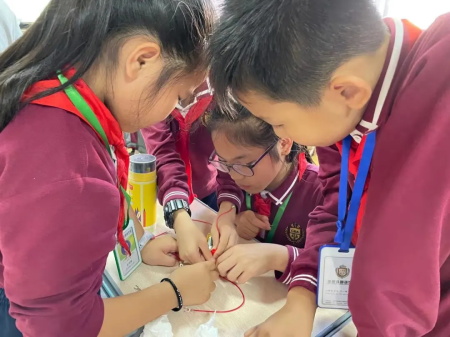继“分析资料”之后,小学PYP 课堂顺利地进入了第三阶段的学习——深入探究。在本阶段的学习中,学生以“抽象——具体——抽象——具体”的闭环式学习顺序,首先学习了能量的主要形式和分类,并生活实际分享交流主要能量转换的实例,继而了解“能量守恒定律”概念,最后以小组协作方式合作探究分析案例并完成实验。
Following the "analysis of data", the primary school PYP classes successfully entered the third stage of learning-in-depth exploration. In this stage of learning, students follow the closed-loop learning sequence of "abstract-concrete-abstract-concrete", first learn the main forms and classifications of energy, and share and exchange examples of major energy conversions in connection with life practices, and then Understand the concept of "Energy Conservation Law", and finally cooperate in group cooperation to explore and analyze cases and complete experiments.
课堂以小组讨论和实验为主轴,着重培养学生“信息素养”探究技能:学生在课堂制定和规划实验分工和流程,进行实验数据收集记录与交流,并对实验过程和结果进行综合和解读,老师对学生探究过程做出形成性评价,营造了“做中学、乐中学”的课堂氛围,引导学生习得研究方法,提高研究技能。
Classroom focuses on group discussion and experimentation, focusing on cultivating students’"information literacy" inquiry skills: students formulate and plan experimental divisions and procedures in the classroom, collect experimental data, record and exchange experimental data, and synthesize and interpret experimental processes and results. Teacher A formative evaluation of the students’ inquiry process is made, creating a classroom atmosphere of “learning by doing and learning by fun”, guiding students to acquire research methods and improve research skills.
世界如何运作?
本轮,四年级探究的超学科主题是:“世界如何运作”。学生主要以“能量的形式与来源”、“能量的储存与转化”、以及“如何合理利用能量”为探究线索学习“能量”。
In this round, the transdisciplinary theme explored in the fourth grade is: "How the world works". Students mainly study "energy" with "forms and sources of energy", "energy storage and transformation", and "how to use energy rationally" as inquiring clues.

概念驱动,评价交流——能量的形式与来源
在深入探究的过程中,学生了解能量的形式与来源,了解了械能、内能、电能、电磁能、核能、化学能、能量守恒定律等科学知识,通过概念驱动学生逐步深入探究,学生交流观察到的生活中各种能量的事例,理解分析主要的能量类型,为进一步研究能量转换提供基础。
Concept-driven, evaluation and communication-the form and source of energy In the process of in-depth exploration, students understand the form and source of mechanical energy, understand the scientific knowledge of mechanical energy, internal energy, electrical energy, electromagnetic energy, nuclear energy, chemical energy, energy conservation law, etc., and drive students to gradually in-depth exploration through concepts , Students exchange observed examples of various energy in life, understand and analyze the main energy types, and provide a basis for further research on energy conversion.
收集记录,综合解读——能量的储存与转换
让学生在“做中学”,在“乐中学”,课堂以两大探究活动为支架,深入研究能量的储存与转换。
Collect records, comprehensive interpretation-energy storage and conversion Let students learn by doing. In our school, the classroom uses two large inquiry activities as a framework to study the storage and conversion of energy in depth.
学生以异质小组形式,讨论与真实生活紧密的趣味故事,从趣味故事中发现能量转换。首先,学生收集并记录发现故事中隐藏的能量转换信息;然后,小组自主制定和规划各成员分工,进行数据分析与综合整理,交流合作完成气泡图、Y形图等不同类型的思维导图;最后,通过小组汇报成果的形式,有层次有条理的解读了化学能转化机械能、化学能转化内能、电能能转化光能等能量转换。
In the form of heterogeneous groups, students discuss interesting stories closely related to real life, and discover energy conversion from interesting stories. First, students collect and record the energy conversion information hidden in the story; then, the group independently formulates and plans the division of labor among members, conducts data analysis and comprehensive arrangement, communicates and cooperates to complete different types of mind maps such as bubble charts and Y-shaped charts; Finally, through the form of the group’s report results, a systematic interpretation of the energy conversion of chemical energy into mechanical energy, chemical energy into internal energy, electrical energy into light energy, etc.
课堂从理论到实践,知行合一,以“点亮小灯泡”实验引导学生继续深入研究电能转化光能的能量转换,思考和讨论如何让电路连接让灯泡亮起来。学生小组协作,经过“分析——评价——形成决定”自主完成能量转换实践:实验前,学生观察与分析实验器材,规划实验步骤;在实验操作中,学生进行数据收集与同步记录,在组内讨论与教师指导下生成形成性评价;在实验结论阶段,学生根据不断调整实验策略,形成实验决定,完成实验报告并绘制电路图。

From theory to practice, the class combines knowledge and action, and uses the "light up a small bulb" experiment to guide students to continue to study the energy conversion of electrical energy into light energy, thinking and discussing how to connect circuits to make the light bulb light up. Students work in a group to complete the energy conversion practice independently through "analysis-evaluation-formation decision": before the experiment, the students observe and analyze the experimental equipment and plan the experimental steps; in the experimental operation, the students conduct data collection and synchronous recording, in the group Formal evaluations are generated under the guidance of internal discussions and teachers; in the experimental conclusion stage, students continuously adjust experimental strategies to form experimental decisions, complete experimental reports and draw circuit diagrams.
在趣味性和操作性极强的活动中,孩子们始终兴趣盎然地积极探究,从交流讨论到实验合作,从失败到成功,孩子们品尝到了探究学习的乐趣,在动手操作中,掌握了探究方法与技能。
In the fun and operation activities, children are always active in exploring with interest. From communication and discussion to experiment cooperation, from failure to success, children taste the fun of inquiry learning, and master the inquiry in the hands-on operation. Methods and skills.
生活,批判思考——如何合理利用能量
老师通过“点亮小灯泡”实验,质疑开关装置是否需要,引发学生批判性思考,如何合理利用能量。学生在讨论中明白节约能源的意义与重要性,在生活中主动肩负起节能环保的责任。
The teacher questioned the need for a switch device through the "light up a small light bulb" experiment, triggering students to think critically about how to use energy rationally. During the discussion, students understand the significance and importance of energy conservation, and take the initiative to take the responsibility of energy conservation and environmental protection in life.